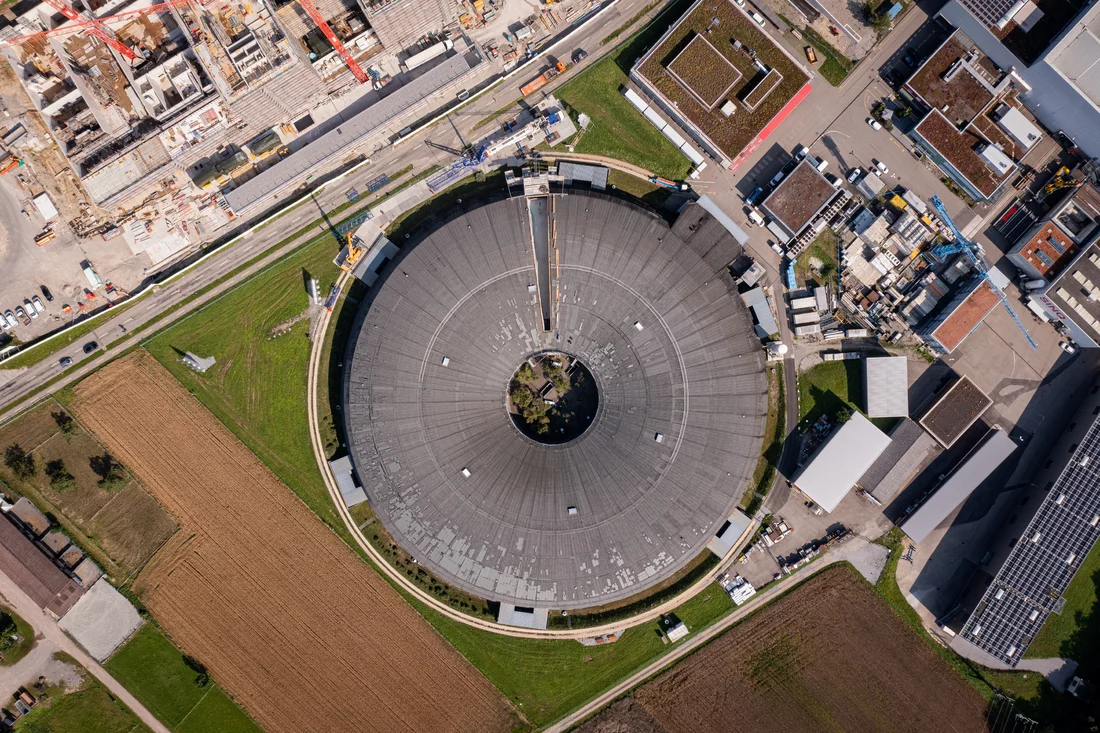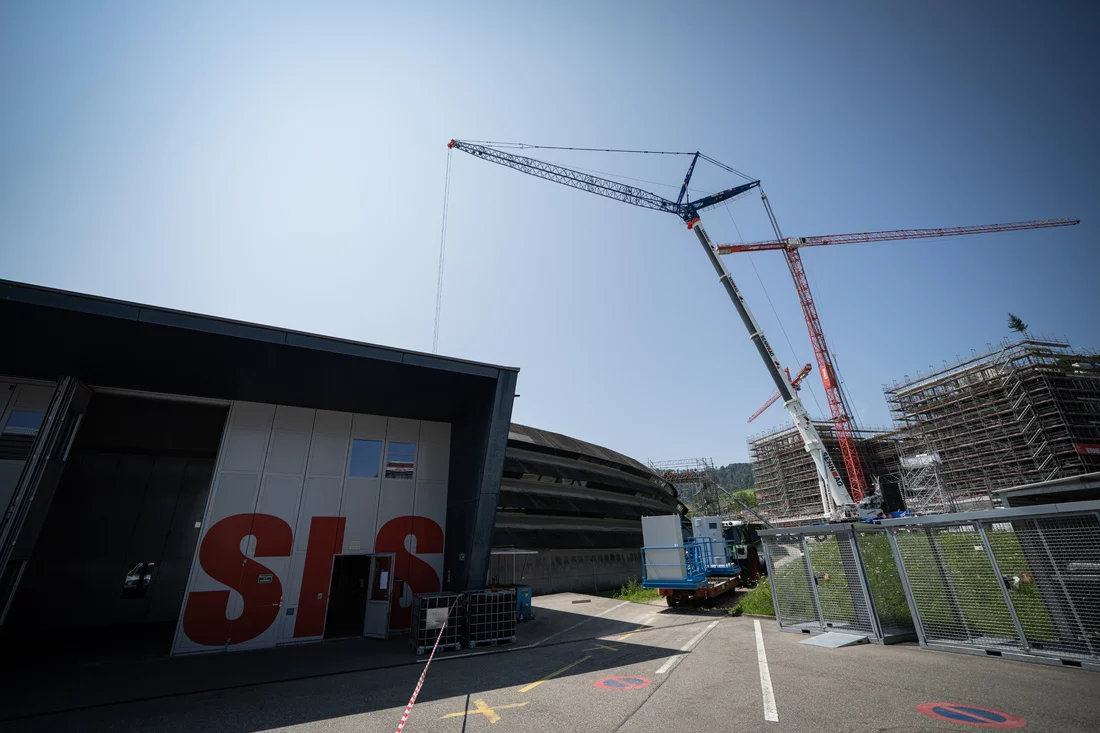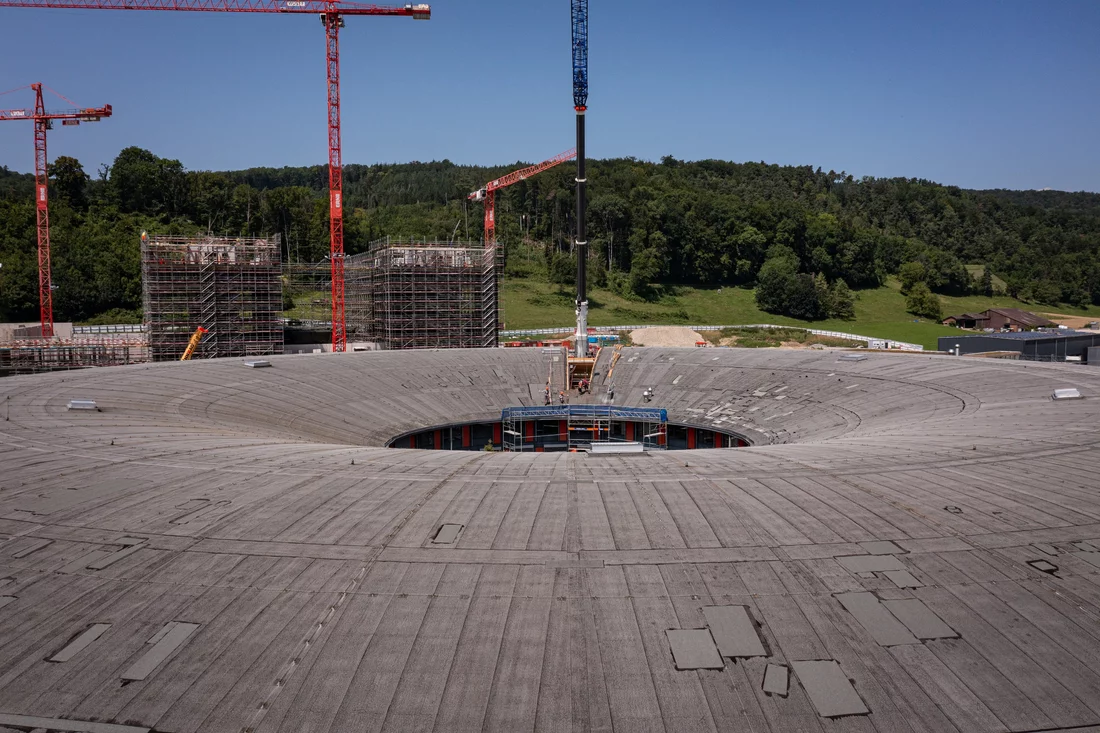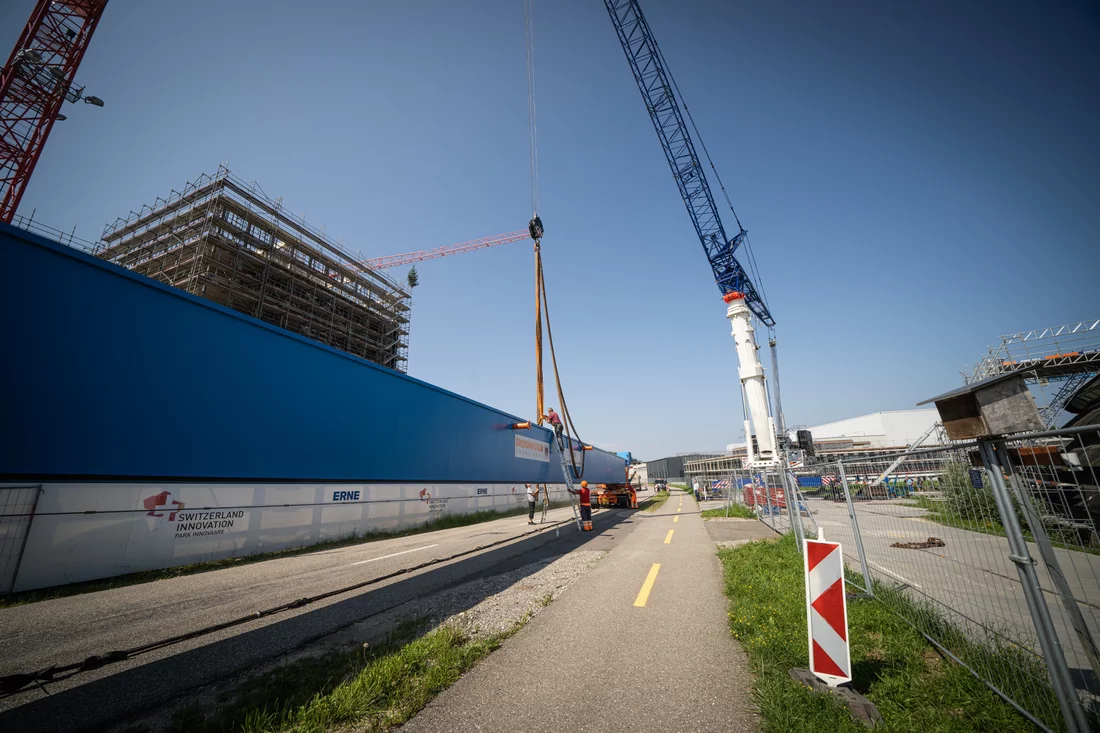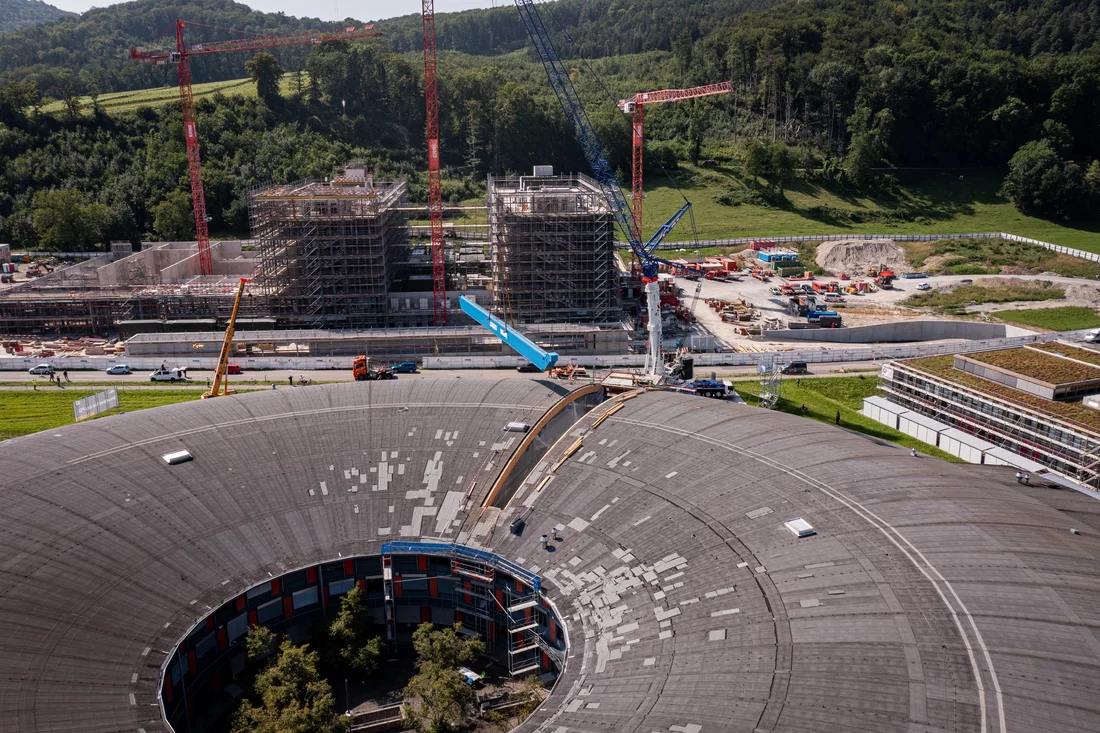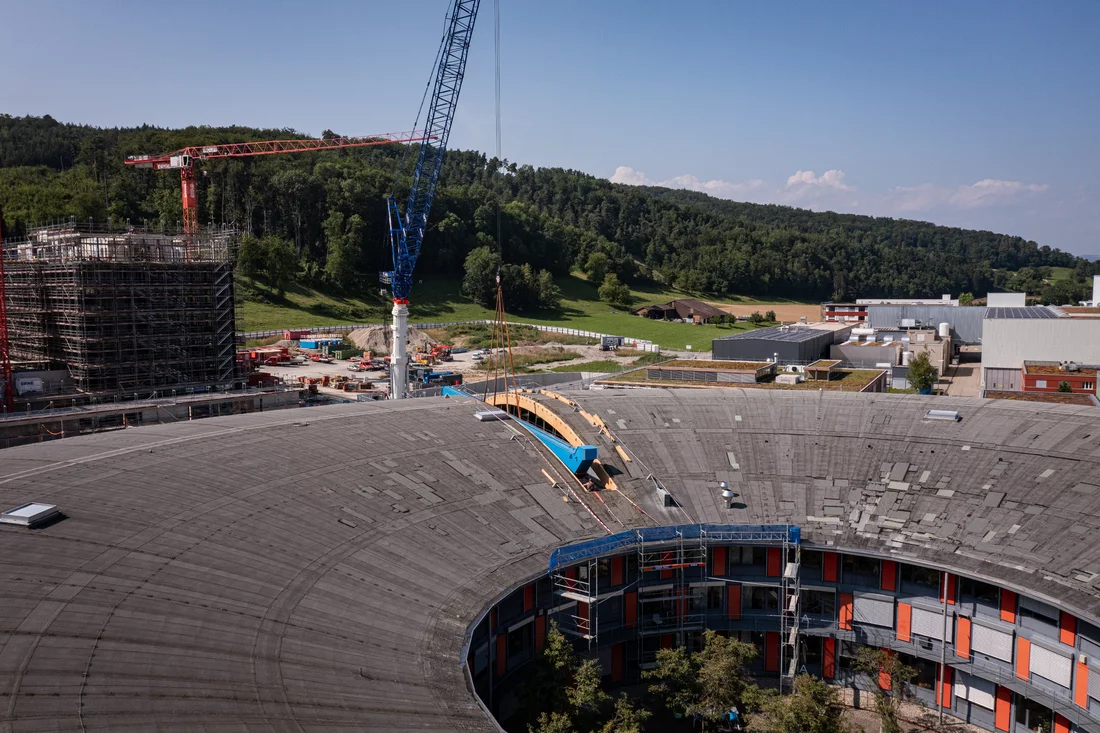In the hall of the Swiss Light Source SLS, a new overhead crane is currently being installed. With its help, the upgrade to SLS 2.0 will be accomplished at a faster pace. But how do you get a 42-metre-long, 40-tonne monster inside a building? The only way is from above: through the roof.
Parked on the main street next to the circular building that houses the Swiss Light Source SLS is a tractor-trailer rig with a load you don't see every day: The trailer sports a blue metal colossus roughly 42 metres long. This is the bridge of the new crane, the largest and heaviest of all the components being installed under the roof of SLS. It is already attached with four slings to the pneumatic crane, more than 80 metres tall, that towers into the sky next to the UFO-shaped building.
The street is temporarily closed to traffic, and dozens of avid spectators have gathered on the bicycle path and the grounds of PSI. They watch spellbound as the huge crane lifts the blue monster and slowly pulls it up. Finally, it hovers over an opening in the roof of the SLS building.
The sun is burning, and construction project manager Oliver Dirr is relieved that the weather actually is as good as the forecast predicted. Rain would have been disastrous for this undertaking: To install the new overhead crane, it was necessary to open up the roof of the SLS building. "We had to completely dismantle one segment of the roof, which meant removing the insulation and cutting out the wooden structure," Dirr explains. "There was simply no other option to bring the gigantic crane into the hall."
If there's one app the project team kept open more or less constantly in recent days, it was the weather app. This operation was actually scheduled for the previous week but had to be postponed due to bad weather.
Doubly useful for SLS 2.0
The new hall crane weighs 40 tonnes in all, its bridge alone nearly 33 tonnes. This addition to SLS is worth a million Swiss francs, financed by funding for the upgrade to SLS 2.0. It is precisely for this purpose that the installation is taking place. In fact, the crane already installed in the hall is powerful enough to do the job alone, but, Dirr explains, "then the work of conversion to SLS 2.0 would take too long. With two cranes, we can work in two different sectors at the same time. Besides that, this means the work doesn't have to come to a standstill if one of the cranes has a failure." The goal is to complete the construction work as rapidly as possible to avoid the loss of measuring time.
With the modernisation project SLS 2.0, the synchrotron source is to be modified in such a way as to deliver even better X-ray light for research. Among other things, the magnet systems that force the electrons onto a circular path are being replaced. The vacuum pipe in the storage ring is also being swapped out.
"Without cranes, the renovation work for the upgrade to SLS 2.0 would be impossible," Dirr says. The magnets, the blocks the tunnel is constructed from – a single load can easily weigh a few tonnes and can't be moved without a crane. A single overhead crane can lift objects weighing up to 16 tonnes; the new crane will be capable of handling up to 18 tonnes in some cases. Its long main bridge is attached with end girders to rails in the centre and on the inner side of the external wall of the circular building; thus the new crane's reach extends over the entire radius of the hall. A movable beam hoist is installed on top, and the loads will be attached to that.
The existing crane is also being upgraded – "trained," as Oliver Dirr puts it. It is being equipped with a positioning system so that, like the new crane, "it will always 'know' exactly where it is." This is especially important because the two cranes can't be allowed to come too close to each other. "There must always be sufficient distance between them," Dirr explains, "since the statics of the building won't tolerate the two cranes being close to each other."
Timed for the shutdown
Slowly, the pneumatic crane operator turns the blue 33-tonne load and lowers it through the opening in the roof of the SLS building. Guide ropes at both ends ensure that it arrives in the right position inside the hall. A lot of care is called for, so that the colossus doesn't bump against lamps or other fixtures. Centimetre by centimetre, the crane bridge approaches the place under the hall's ceiling where it will be mounted on the end girders.
No measurements are being made at SLS today; many areas are even cordoned off with barrier tape. The crane installation has been scheduled to coincide with the annual summer shutdown, explains Oliver Bunk, head of PSI's Laboratory of Macromolecules and Bioimaging, who is also responsible for the SLS facility. "We have coordinated it in such a way that there will be no additional loss of measuring time due to the crane installation. In the course of the upgrade to SLS 2.0, many such arrangements will have to be worked out," he adds. "Vibrations caused by crane travel can disturb SLS operations."
Once the main bridge of the crane has been successfully installed, everyone responsible feels a sense of relief. This tricky and potentially dangerous part of the project is complete. Nevertheless, it's no time to rest. Oliver Dirr's weather app indicates thunderstorms again for the day after next. The missing segment of the roof absolutely must be replaced and sealed with bitumen before the storms arrive.
Text: Paul Scherrer Institute/Brigitte Osterath
Contact
Oliver Dirr
Construction Project Manager AIB
Paul Scherrer Institute, Forschungsstrasse 111, 5232 Villigen PSI, Switzerland
Telephone: +41 56 310 25 34, e-mail: oliver.dirr@psi.ch [German, English]
David Reinhard
Section Leader Technical Building Infrastructure
Paul Scherrer Institute, Forschungsstrasse 111, 5232 Villigen PSI, Switzerland
Telephone: +41 56 310 54 48, e-mail: david.reinhard@psi.ch [German, English]
Dr. Oliver Bunk
Head of the Laboratory of Macromolecules and Bioimaging
Paul Scherrer Institute, Forschungsstrasse 111, 5232 Villigen PSI, Switzerland
Telephone: +41 56 310 30 77, e-mail: oliver.bunk@psi.ch [German, English]
Copyright
PSI provides image and/or video material free of charge for media coverage of the content of the above text. Use of this material for other purposes is not permitted. This also includes the transfer of the image and video material into databases as well as sale by third parties.

